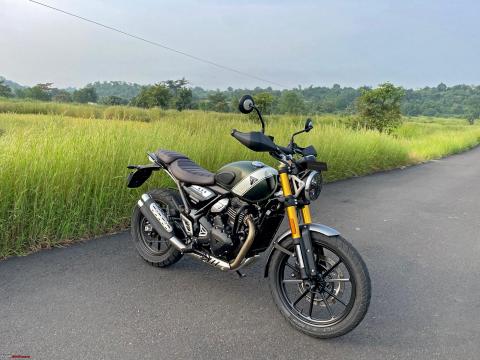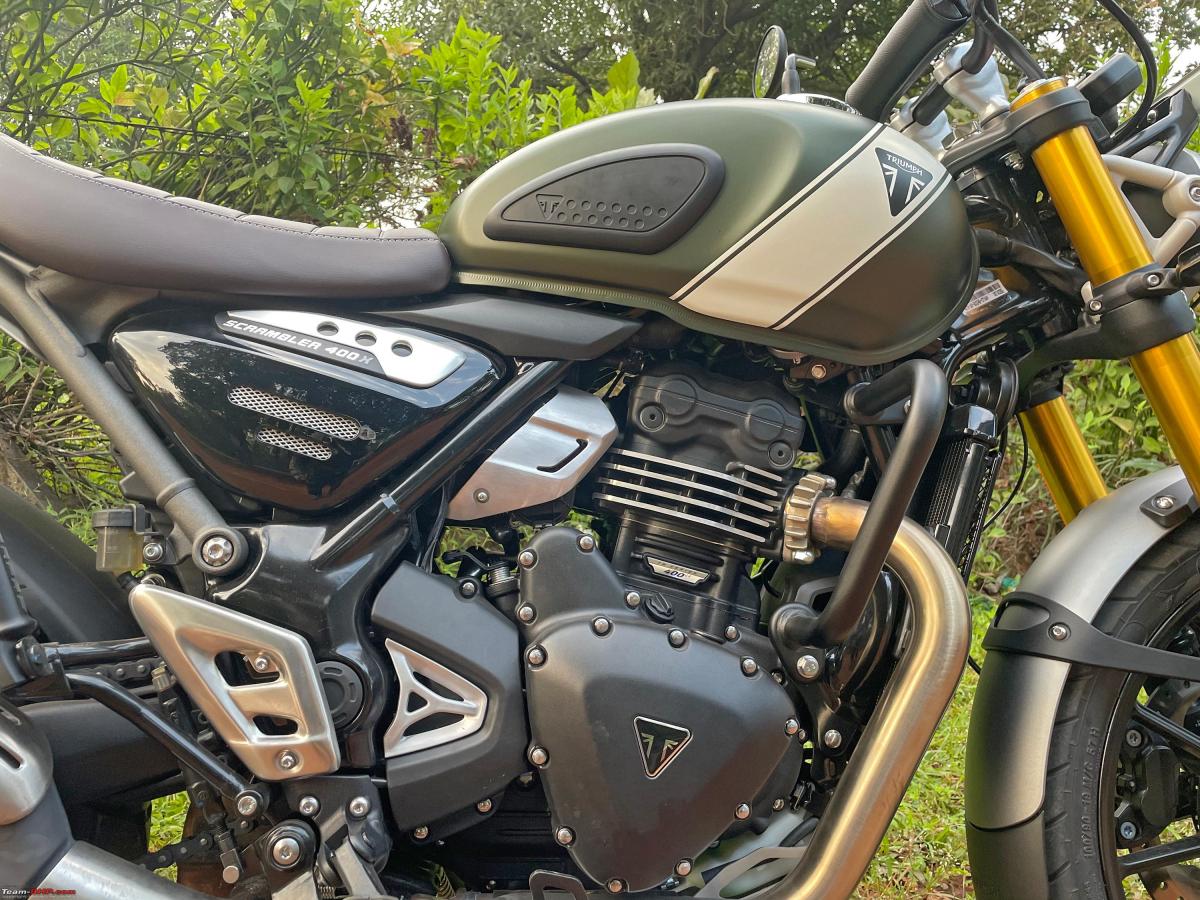Triumph Scrambler 400 X : Observations after a day of riding
Handling, despite the 19” wheel, longer wheelbase and taller stance remains as engaging as one expects from any Triumph and even in Scrambler guise, this 400 X is immensely flickable, agile and quick to change direction as and when you need. This bike can be pushed and it’ll be rewarding enough, specially with the go anywhere peace of mind that comes with its XL ground clearance.
Riding the Triumph Scrambler 400 X
Triumph had organised our media ride at a place a little off Kolad, in the interiors of Maharashtra. The location provided ready access to some inner broken B roads as well as straight access leading up to the smooth and flowing twisties of the Tamhini Ghat. While there were some trails going around these routes as well, I was completely alone without a backup car like most. So I simply did not want to risk getting overly adventurous and that too with a test mule. I managed to get 100 – 120 km of riding on a mix of broken small inner roads, as some of the pictures will show, as well as some lovely flowing tarmac where one could push the bike a bit.
Before we come to the ride review, let’s spend a little time on the few changes to the bike compared to the Speed. The engine remains the same as the Speed – i.e. – the brand new 398cc single-cylinder, liquid-cooled engine sporting a four-valve, double overhead camshaft setup producing a healthy 39.5 BHP @ 8,000 rpm and 37.5 Nm @ 6,500 rpm delivered via a relatively linear torque curve. However, it has undergone a few tweaks to customise it for this scrambler-styled offering. While the frame architecture of the chassis remains the same, the head stock is further away from the rider as compared to the Speed. The bike also sports a steeper rake angle and increased trail thereby inspiring a lot more confidence in the varied conditions it’ll be subjected to. The front:rear weight distribution has been tweaked to a 48:52 ratio from the 47:53 of the Speed. The other key change is on the sprocket – where the Speed has a 43/15 set up, the Scrambler sports a 43/14 setup in order to boost low-end performance. Other related changes of course are mostly to the ergonomics of the bike which have already been discussed in the previous post.
As with the Speed, given its identical engine setup, the Scrambler too remains smooth and measured in how it delivers its power. The engine is reasonably tractable so you can pull the bike back even if you’re in a higher gear than you should be, without the engine complaining too much. Most of the power delivery observations that were made to the Speed hold good for the Scrambler as well and we will not delve into those in too much detail to avoid repetition.
For me personally, given that the majority of my riding experience in recent years has been on more upright adventure-style bikes, the Scrambler immediately felt much more like familiar territory compared to the Speed. I liked its more generous proportions and upright riding posture and despite its tall stance, thanks to its narrow seat and low kerb weight, the bike never felt unwieldy or overwhelming to me. While the riding character is obviously not as sharp as the Speed, the bike is still immensely chuckable and brings in a fun-to-ride quotient in typical Triumph fashion.
Even though its performance is not explosive like the much more aggressive KTMs, it is still playful enough whether you are blazing down broken roads or blasting down on smooth tarmac with twisties, like what we had on offer on the route to Tamhini ghat. I didn’t manage to clock / time my runs the way I could on the Speed, thanks to our time at the Chakan test track, but I expect the in-gear acceleration and top speed figures to be similar to the Speed barring some difference on account of the different sprocketing / final drive for the Scrambler and its slight extra weight.
In terms of different use case scenarios and riding conditions, this Scrambler retains its easy, flickable characteristic and is going to be a fairly versatile companion. It should be a breeze to nip in and out of city traffic, as well as at ease for highway duties and any trails or mild off-roading situations should you venture off the beaten path. I’ve done reasonably adventurous sort of riding on a 19” alloy front wheel without feeling any deal breaker issue or missing larger 21” spoke wheels so I don’t expect this to be any different. It should get the job done in most such situations without any fuss for the rider.
The bike should have enough grunt for two-up riding as well although if you plan to tour with a pillion on this machine, I expect its sweet spot to be in the 80 – 100 km/h zone. The step-up seat is also something users should carefully consider from a pillion comfort standpoint. It is a typical scrambler style of seating and larger pillions may find the pillion seat a tad compact, especially over longer distances.
Refinement & NVH
The engine is very refined with a nice throaty growl from the exhaust. I believe they’ve tweaked the exhaust tune on the Scrambler to provide a slightly more pulsy note but honestly, the difference may be extremely nominal between the two bikes.
Just like the Speed, while there is no excessive buzz or vibrations during typical riding conditions, some vibrations do creep in beyond 7,000 rpm or so. The mirrors, again like the Speed, start blurring out somewhere post 6,000 rpm – something to be mindful of. I personally didn’t find the vibrations a fatal issue, but opinions and tolerance towards this is clearly varied and this is, again, something each rider may want to consider carefully based on his / her own preference.
Suspension and Handling
The bike sports a 43 mm upside-down big piston fork suspension at the front, with 150 mm wheel travel while the rear is brought up by a gas monoshock RSU with an external reservoir and 10-step pre-load adjustment, again sporting 150 mm of wheel travel. Each is made by Endurance, a Bajaj sister concern.
I didn’t check the stock setting in which they gave me the bike, but I found the ride quality supple enough for comfort in my time spent on some broken B roads. The suspension set up is outstanding and the bike was perfectly at ease going through typically broken roads, potholes and whatnot – at no point did it feel skittish or even too firm. The ground clearance is of course excellent. I can confidently say it’s more than capable of handling whatever our regular roads throw up.
Handling, despite the 19” wheel, longer wheelbase and taller stance remains as engaging as one expects from any Triumph and even in Scrambler guise, this 400 X is immensely flickable, agile and quick to change direction as and when you need. This bike can be pushed and it’ll be rewarding enough, specially with the go anywhere peace of mind that comes with its XL ground clearance. Don’t expect manic performance or raw thrills – this is a more sophisticated and measured riding experience – but pushed hard, it’s playful enough for most.
Braking
Brakes are by ByBre, Brembo’s budget brand that is now almost par for the course in this segment with both the KTM Duke and Harley 440 X also opting for these. The front brake has a 320 mm fixed disc with a four-piston radial caliper, while the rear sports a 230 mm fixed disc with a floating caliper. Braking power is more than adequate and just like the Speed, I did some planned urgent braking on a few occasions and found them to be up to the mark. Again, segment standard components here give no cause to complain about their performance.
Closing Thoughts
Just like the Speed, the Scrambler rides beautifully. There’s hardly a fatal flaw and they’ve clearly delivered a brilliantly engineered, premium product at an honest price. But unlike the Speed, I do believe that the Scrambler has its work cut out just a bit more. The Speed has clear blue sky in price between itself and the more enticing Duke 390 and reasonably distinct product delineation with the Royal Enfield Classic, Hunter and the Hero Harley 440. The Scrambler, however, is expected to go head-on against what is expected to be an extremely capable 2.0 iteration of the Himalayan (452) with the base (X) variant of the 390 Adv not being too far off the mark either. While the Triumph and Scrambler brand equity is compelling, that of the Himalayan as well as the KTM are not to be scoffed at either. The launch of its closest competitor is expected close on the heels of the Scrambler and I can’t wait to see these two brands slug it out for their share of the market. The competition will only stiffen further once the next generation of the 390 ADV also hits the market.
All in all, the 400cc segment is getting extremely competitive and with such a range of extremely capable products, in the ultimate analysis, the customer is definitely the winner.
Source: Read Full Article



